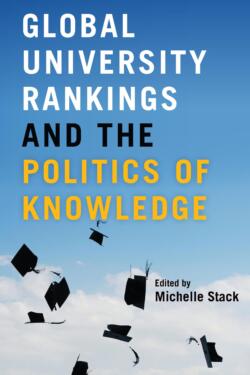1396 The reputational arms race
Global University Rankings and The Politics of Knowledge
by Michelle Stack (editor)
Toronto, University of Toronto Press, 2021
$32.95 / 9781487523398
Reviewed by D.G. Marshall
*
 Rankings. North American consumers are obsessed with rankings. We rank things — cars, putters, TVs, computers, lingerie, bicycles, hiking boots, lightbulbs. We rank food and drink — macaroni, beer, whiskey, wines, popcorn, spinach, pizza. We rank people — doctors, politicians, mechanics, professors. We rank services — real estate agents, electricians hairdressers, tattoo artists, restaurants. People can make a living doing YouTube product reviews. Most Canadians would never think of buying any product or service without first checking out the “ranking” or, at the very least, the ‘reputation’. In the imaginable past (for someone my age), we relied upon such venerable sources as Consumer Reports, Ralph Nader or the Better Business Bureau to make sure that we didn’t fall down a rabbit hole of wild quality claims. Today, of course, a click and search — “Google? what is the best xxx?” — leads us to an indigestible array of rankings and reviews of every known product or service, and there is very little to help us maneuver around that hole. The authors of this book go beyond superficial measures to help university consumers navigate the ‘rabbit hole’ of global university rankings.
Rankings. North American consumers are obsessed with rankings. We rank things — cars, putters, TVs, computers, lingerie, bicycles, hiking boots, lightbulbs. We rank food and drink — macaroni, beer, whiskey, wines, popcorn, spinach, pizza. We rank people — doctors, politicians, mechanics, professors. We rank services — real estate agents, electricians hairdressers, tattoo artists, restaurants. People can make a living doing YouTube product reviews. Most Canadians would never think of buying any product or service without first checking out the “ranking” or, at the very least, the ‘reputation’. In the imaginable past (for someone my age), we relied upon such venerable sources as Consumer Reports, Ralph Nader or the Better Business Bureau to make sure that we didn’t fall down a rabbit hole of wild quality claims. Today, of course, a click and search — “Google? what is the best xxx?” — leads us to an indigestible array of rankings and reviews of every known product or service, and there is very little to help us maneuver around that hole. The authors of this book go beyond superficial measures to help university consumers navigate the ‘rabbit hole’ of global university rankings.

Global University Rankings and the Politics of Knowledge is a collection of ten essays providing diverse scholarly perspectives on the relationship between national universities and global ranking. The editor (and chapter contributor) of the collection is Michele Stack, an Associate Professor in Education at UBC (University of British Columbia). The chapter authors are an international collection of (mostly Education) academics representing Canada (UBC, Lethbridge, McGill, Toronto, Ottawa, York, University of Victoria), Japan (Osaka University), Taiwan (National Chengchi University), USA (Michigan State, Indiana), and Mexico (National Autonomous University of Mexico). The authors appear to be connected by a scholarly interest in various dimensions of “decolonial studies…the intersection of power and knowledge within the wider contexts of politics, culture and the economy…” Each author takes a unique national perspective on the “colonial” effects of GURs (Global University Rankings), but collectively, they represent an impressive mix of both knowledge and analysis on the subject of GURs.

This book is not a nuanced, balanced, analysis of the GURs. As the editor suggests in a brief descriptive preface, the collection of articles “…exposes how universities become servants to the ranking industry and its impact…” The book focuses on the “big three” of GURs — the Academic Ranking of world Universities (ARWU), the Times Higher Education World University Ranking (THEWUR) and the Quacquarelli Symonds (QS) — though the editor points out that there are over 150 national university rankings and another twenty that claim global status. The chapters are appropriately organized into three themes, each taking critical aim at the GURs from a different conceptual or national angle.
The three authors in the theme Geopolitics , Rankings, and Journal Impact Factors address what one reference refers to as the Harvardometer effect on cultural imperialism. Essentially the GURs promote an Anglo Saxon-Western Northern hemisphere-based university model that ignores local priorities, needs and knowledge. And this perspective is supported by the fact that most of the top ten globally ranked Universities are either in southern England, or the US Eastern seaboard or California. One chapter focuses on Latin America, another on Central Asia. A third chapter provides a fascinating analysis of the visual effects of GUR websites and how they present various nationality universities. Generally the authors in this theme question the claims of objectivity of the ranking exercises and point out how the rankings can distort academic work and government investment in universities.

The authors in the second theme delve more into the measures used in the GUR rankings, in particular measures of research productivity such as citation indexes, measures that can account for over a third of the university ranking score. Most university academics are aware of the challenges of using citations as a measure of scholarly prestige and productivity (plagiarism, insignificant statistical differences, multiple authors, discipline differences, citation index validity, and so on), and the authors in this section observe some of the special challenges with GURs. Essentially, the algorithms on which the GURs is based may not be accurate or representative of “good” scholarship. One chapter in this theme examines these effects in Taiwan. The second examines the rationale for calls for change in the manner that research and productivity are assessed, highlighting the alternate, quality focussed process at the University of Ottawa. The third chapter examines why universities in the southern hemisphere can’t crack the GUR rankings, raising the question of just what a university in the Global South” can actually do to improve its rankings?
The third theme shifts to an examination of the effects that the GURs — the “reputational arms race,” as one author calls it — have on a personal level rather than just an institutional or national level. One chapter explores how GURs have fundamentally altered the traditional Japanese “admission to degree to employment” continuum. The author of the second chapter reports his research examining how academic and non-academic individuals view the rankings and their measures, in particular the effects upon reputation. In the third chapter in this theme, the author focussed on the psychological effects on faculty members who work at institutions ranked in the THEWUR. The author reports an empirical relationship between faculty and student motivation and rankings. In the final chapter in the book, the Editor considers the next steps in an examination of GURs and their impact. The recent university admission scandal in the US provides stark and startling evidence of what the rankings can motivate. This chapter summarizes the arguments for and against the GURs, emphasizing the hegemonic, cultural colonialism, theme consistent to all chapters of the book.

Global University Rankings and the Politics of Knowledge is a well-organized and well-written book that adds academic perspectives to the discussion of the purpose and impact of GURs. Particularly useful is the research and empirical basis provided by the articles. There is never any shortage of pundits (like me?) sharing an opinion on rankings, so it is refreshing to have perspectives based upon actual research. The book also provides a one stop shop for the current academic literature on university rankings. The introduction chapter alone includes over 100 references, and a rough compilation of all ten chapters suggests over 500 ranking relevant references. Depending upon their motivation or needs, the reader might find both the citations and the discipline based language overwhelming at times. Fortunately, each chapter provides a cogent summary of the research and the implications. But, in general, this book represents a thorough academic discussion on the various global impacts of GURs.
Who will want to read this book? Academics in related disciplines for sure. As suggested, the authors provide an extensive reference list for the discussion of rankings. University faculty associations (and management?) everywhere might refer to the research in this book to enhance discussions on the use of scholarly evidence — especially citation indexes — for appointment, promotion and tenure. Governors, donors and marketing offices should read this book and reconsider their crass use of rankings (national or global) for any functional purpose. This should be an urgent read for non-western, non-northern, government and university leaders. While accepting the notion that existing university quality assessment in many countries might need reform, the notion that GURs are a replacement for local quality assessment needs to be questioned. Finally, the themes and national case studies from elsewhere could help Canadian leaders understand why university rankings of any sort haven’t taken hold in Canada (other than as a commercial enterprise and for applicants that can’t read). As a public system (with minor exceptions) Canadian universities are of homogenous high quality. There is no need for a ranking system compliant with a set of external standards in order to protect the consumer. Every Canadian university will provide an outstanding undergraduate experience, though any analysis that explains the significant differences between Canadian universities is most appropriate (e.g. National Study of Student Engagement). In addition, Universities Canada provides a form of national accreditation by requiring a set of institutional factors (not ranked outputs) for membership. And unlike other places in the world, not many Canadian students are looking for an undergraduate, international experience and are not likely to be swayed by an institutional global ranking in the top 1000 of universities worldwide.

However, that brings me to my only (perhaps unfair) substantial criticism of this book. Despite the fact that the editor and most of the contributors are Canadian and are scholars at a Canadian university, there are only a few passing references in this book to any Canadian university, and no discussion of the application of this very thorough analysis to the Canadian circumstance. Specifically, while it arguably beyond the scope of this book, some assistance in how to respond to parents, governors, the government and the media regarding the national and international university rankings of Canadian universities would have been useful. I realize that the Maclean’s ranking exercise has generated its own cottage industry of both academic and institutional critics.
And, from my humble perspective as a long time university President, the Maclean’s rankings are more entertainment than substance. After almost thirty years of publication, those institutions that (ad nauseam) rank at the top still parade the results in their marketing materials, and those further down treat the experience with a modicum of resignation and humour. (Ranked in last place, one institution sent out a tongue in cheek message proudly claiming “When you are 22nd you try harder”—with apologies to 1962 AVIS.) Furthermore, as suggested above, few governments, boards or even the media have a clue — or care — which (or why) Canadian universities are included in any of the international rankings. (There are 5 in the top 200 and 32 in the top 1000 THE rankings. When you are 980th you try harder?). But none the less, some help for leaders to intelligently discuss the annual ranking exercises would be welcome. Why should Canadian universities be any less concerned — or vulnerable — to the effect of the “Harvardometers,” or to the motivations of commercial media?
As a leader who has been concerned for many years about the system effects of university ranking exercises, I enjoyed — and learned from — a book that helps frame my criticism in a more intellectual and scholarly fashion. Thanks for that. This book is a significant contribution to the discussion of national and global rankings.
*

D.G. (David) Marshall is past president of Mount Royal and Nipissing Universities. He lives in Calgary.
*
The Ormsby Review. More Books. More Reviews. More Often.
Publisher and Editor: Richard Mackie
The Ormsby Review is a journal service for in-depth coverage of BC books and authors in all fields and genres. The Advisory Board consists of Jean Barman, Wade Davis, Robin Fisher, Cole Harris, Hugh Johnston, Kathy Mezei, Patricia Roy, Maria Tippett, and Graeme Wynn. Scholarly Patron: SFU Graduate Liberal Studies. Honorary Patron: Yosef Wosk. Provincial Government Patron since September 2018: Creative BC
“Only connect.” – E.M. Forster